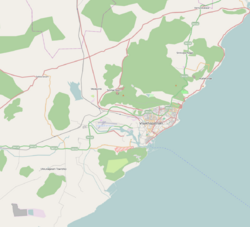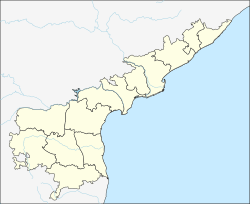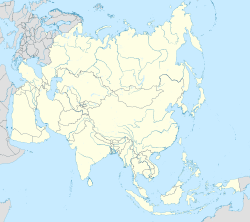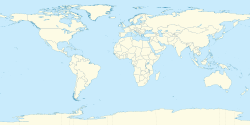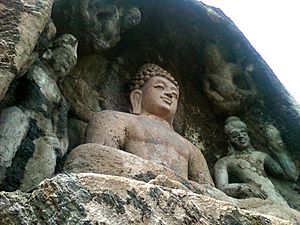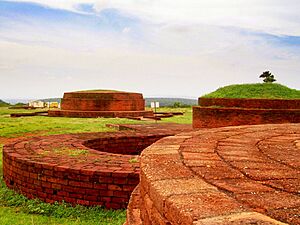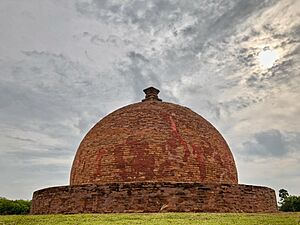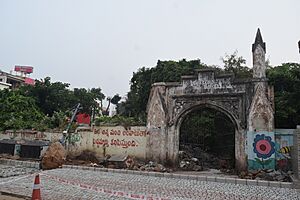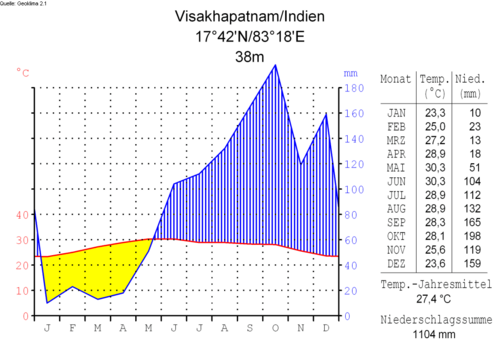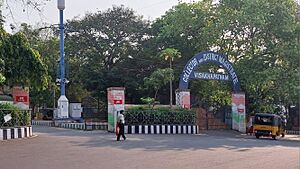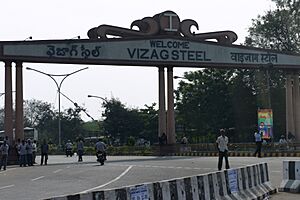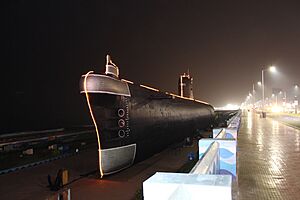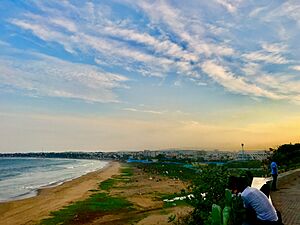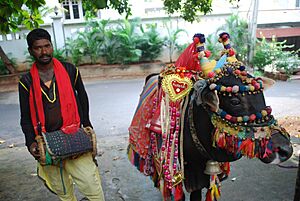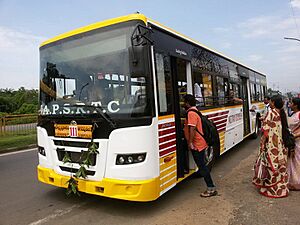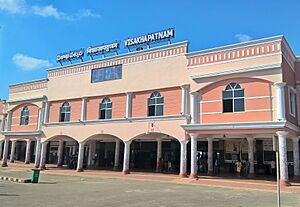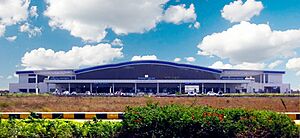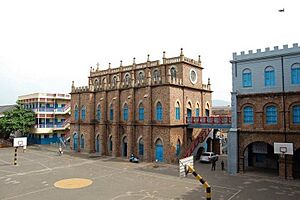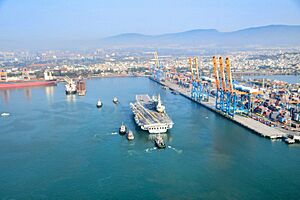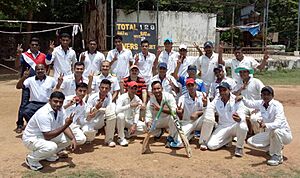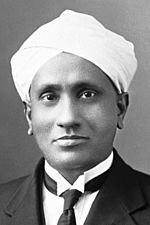Visakhapatnam facts for kids
Quick facts for kids
Visakhapatnam
Vizag, Vizagapatam, Visakha, Waltair
|
|
|---|---|
|
Clockwise from top: Skyline of Visakhapatnam, Beach ship at Tenneti Park, Lord Shiva & Parvathi statues on Kailasagiri, Visakhapatnam Port, Kambalakonda Wildlife Sanctuary and Old Vizag Lighthouse on RK Beach
|
|
| Nickname(s):
The City of Destiny
The Jewel of the East Coast |
|
| Country | |
| State | Andhra Pradesh |
| Districts | Visakhapatnam, Anakapalli |
| Incorporated (town) | 1865 |
| Incorporated (city) | 1979 |
| Government | |
| • Type | Municipal Corporation |
| • Body | GVMC, VMRDA |
| Area | |
| • Metropolis | 640 km2 (250 sq mi) |
| • Metro | 7,328.86 km2 (2,829.69 sq mi) |
| Population
(2011)
|
|
| • Metropolis | 2,091,811 |
| • Estimate
(2021)
|
2,358,412 |
| • Rank | 17th |
| • Density | 3,268/km2 (8,470/sq mi) |
| Demonym(s) | Vizagite |
| Time zone | UTC+5:30 (IST) |
| PIN |
530 0XX, 531 1XX
|
| Telephone code | +91-891 |
| Vehicle registration | AP-31, AP-32, AP-33, AP-34 , AP-39 |
| Official languages | Telugu |
| Website |
|
Visakhapatnam (also called Vizag) is a big and busy city in Andhra Pradesh, India. It sits between the Eastern Ghats mountains and the Bay of Bengal coast. It is the second largest city on India's east coast, after Chennai. It is also one of India's "Smart Cities," which means it uses technology to improve life for its people.
This city has a long history, going back to 600 BCE. It was once an old port city that traded with places like the Middle East and Rome. Many different rulers controlled Visakhapatnam over the centuries. In 1804, the East India Company took control, and it remained under British rule until India became independent in 1947.
Today, Visakhapatnam is home to important schools and universities. It is also a major base for the Indian Navy and has the oldest shipyard in India. The Visakhapatnam Port is one of the busiest in the country. The city is a popular tourist spot, famous for its beautiful beaches, ancient Buddhist sites, and green mountains. People often call it the "City of Destiny" or the "Jewel of the East Coast."
Contents
- What's in a Name?
- A Look at Visakhapatnam's Past
- Visakhapatnam's Location and Climate
- People of Visakhapatnam
- How the City is Run
- Visakhapatnam's Economy
- Exploring Visakhapatnam
- Visakhapatnam's Culture
- Getting Around Visakhapatnam
- Learning in Visakhapatnam
- Defence and Research
- Sports in Visakhapatnam
- Media and Entertainment
- Famous People from Visakhapatnam
- Images for kids
- See also
What's in a Name?
The name Visakhapatnam has a few interesting stories behind it. One local belief says that a king in the 4th century built a temple for a god named Vaisakha. This temple was later covered by the sea, but the city kept the name.
Other names for the city include Kulotungapatnam, named after a king, and Ishakapatnam, after a Muslim saint. When the East India Company ruled, they called it Vizagapatam. This name was often shortened to Vizag, which locals still use today. The area known as Waltair also comes from a British name.
A Look at Visakhapatnam's Past
Visakhapatnam's history goes back thousands of years. Ancient writings from the 4th century BCE mention this area. It was part of the Kalinga region and was ruled by various kingdoms like the Vengi and Pallava dynasties.
Around the 11th and 12th centuries CE, the city we know today began to form. Control of the city often changed hands between different empires. European traders, including the French and the British, later set up businesses here. By the late 1700s, the French ruled the city.
In 1804, the East India Company took over Visakhapatnam. It stayed under British rule until India gained its freedom in 1947. The British developed the city's port, making it an important trading hub.
Buddhist History in Visakhapatnam
Long ago, around 500 BCE, the Visakhapatnam area was part of the Kalinga kingdom. Evidence shows that a Buddhist empire also existed here. After a big battle, King Ashoka became a Buddhist, and the religion spread. Many ancient Buddhist sites have been found around Visakhapatnam, showing its strong Buddhist past.
Pavurallakonda: Pigeon Hill
Pavurallakonda means "pigeon hill." It is a small hill about 24 kilometers from Visakhapatnam. Archaeologists believe a Buddhist community lived here from the 1st century BCE to the 2nd century CE. On the hill, there are 16 rock-cut pools that collected rainwater.
Sankaram: A 2,000-Year-Old Site
In 1907, a British archaeologist found Sankaram, a Buddhist site that is 2,000 years old. The name "Sankaram" comes from "Sangharama," which means temple or monastery. This important site is about 40 kilometers south of Visakhapatnam. All three main types of Buddhism (Hinayana, Mahayana, and Vajrayana) were practiced here. The site has large stone stupas (dome-shaped structures), rock-cut caves, and brick buildings.
Bavikonda: Hill of Wells
Bavikonda is another important Buddhist site on a hill about 15 kilometers northeast of Visakhapatnam. The Hinayana type of Buddhism was practiced at the monastery here between 300 BCE and 300 CE. Bavikonda has the remains of 26 Buddhist buildings. A piece of bone found here, stored in an urn, is believed to be from the Buddha himself. The name Bavikonda means "a hill of wells" in Telugu, because the hill has wells to collect rainwater.
Thotlakonda: Hilltop Buddhist Complex
About 16 kilometers from Visakhapatnam is Thotlakonda, a Buddhist complex on top of a hill. It was discovered during an aerial survey. The government declared this 48-hectare site a protected monument in 1978. Digs have uncovered many structures, including a large stupa, prayer halls, and dining halls. Important items found include Roman and Satavahana coins, pottery, and small Buddha statues. Thotlakonda reminds us of the ancient Buddhist civilization that once thrived in southern India.
Recent History
After the British took over, Visakhapatnam became part of the Madras Presidency. It was a very large district until it was divided into smaller districts after India's independence. Part of the city is still called Waltair, which was its colonial British name.
In May 2020, there was an industrial accident in the city. A chemical plant leaked toxic gas, which sadly caused some deaths.
Visakhapatnam's Location and Climate
Visakhapatnam is located between the Eastern Ghats mountains and the Bay of Bengal. The city covers an area of 682 square kilometers. Its average height above sea level is 45 meters.
The city is surrounded by hills like the Simhachalam Hill Range, Yarada Hills, and Kambalakonda Wildlife Sanctuary. These hills are important for the city's natural environment.
Hills Around Visakhapatnam
- Eastern Ghats
- Simhachalam Hills
- Yarada Hills
- Erra Matti Dibbalu
- Dolphin's Nose Hills
- Kailasagiri Hills
Weather in Visakhapatnam
Visakhapatnam has a tropical climate, meaning it is warm all year round. The average temperatures are between 24.7 and 30.6 degrees Celsius. May is usually the hottest month, and January is the coolest. The highest temperature ever recorded was 45.4 degrees Celsius, and the lowest was 10.5 degrees Celsius.
The city gets rain from both the southwest and northeast monsoons. The average yearly rainfall is about 1118.8 millimeters. In October 2014, a strong storm called Cyclone Hudhud hit the city. Visakhapatnam has been ranked as the 22nd cleanest city in India among large cities.
People of Visakhapatnam
As of 2011[update], Visakhapatnam had a population of about 1.7 million people. For every 1000 males, there were 978 females. About 81.79% of the people could read and write. The city is one of the fastest-growing cities in the world. Many people, about 44.61%, live in slum areas.
The latest estimates for 2022 show the city's population is around 2.3 million.
Languages and Religions
Telugu is the main language spoken in Visakhapatnam, by over 92% of the people. There are two main ways of speaking Telugu here: the common way and the North Eastern Andhra way. The city also has people who speak Urdu, Hindi, Odia, Tamil, Malayalam, and Bengali. There is also an Anglo-Indian community, who were among the first diverse groups in the city.
| Religion in Visakhapatnam (2011) | ||||
|---|---|---|---|---|
| Hinduism | 92.32% | |||
| Islam | 3.85% | |||
| Christianity | 3.07% | |||
| Other or not stated | 0.76% | |||
Most people in Visakhapatnam practice Hinduism. After that, Islam and Christianity are the next most common religions. Although Buddhism was important in the past, very few people practice it in the city today.
How the City is Run
The Greater Visakhapatnam Municipal Corporation (GVMC) is the local government that manages the city's needs. It was first set up in 1858 as a municipality and became a municipal corporation in 1979. The GVMC covers a large area of about 682 square kilometers. This includes nearby towns like Gajuwaka, Anakapalle, and Bheemunipatnam.
The city is divided into 9 zones, and it has 98 wards (smaller areas). The GVMC collects money through property taxes and other fees to fund its services.
The Visakhapatnam Metropolitan Region Development Authority (VMRDA) is another agency that plans for the city's growth. It is working on long-term plans for the city's development, including transportation, economic growth, and tourism.
City Services
The Andhra Pradesh Eastern Power Distribution Company Limited (APEPDCL) provides electricity to Visakhapatnam. The city's fire services are handled by the state fire department.
Visakhapatnam gets its water mainly from surface water sources, stored in large reservoirs. About 54.9% of homes have piped water connections. The city is working to improve its underground drainage system, as only about 50% of the city currently has access to it. In 2015, the city produced 920 tons of waste every day, which is taken to a dumpsite.
Visakhapatnam's Economy
Visakhapatnam is one of the fastest-growing cities in the world. It is the 9th richest city in India. The city's port is very important for exporting seafood. Visakhapatnam Port and Gangavaram Port are the two main ports. The Hindustan Shipyard builds and repairs ships for the navy.
Technology and Industry
The technology sector has been growing a lot in Visakhapatnam. In 2016–17, the IT industry here made about 54 billion Indian Rupees. Places like Sunrise Startup Village and Fintech Valley Vizag help new technology companies grow. Many big IT companies like IBM, Wipro, and Tech Mahindra have offices here.
The Brandix India Apparel City is the largest textile park in India. It employs over 15,000 women in one location.
Visakhapatnam also has many pharmaceutical companies in the Jawaharlal Nehru Pharma City. There are also aluminum refineries and power plants. The city is part of a large industrial region that is expected to create many jobs.
Exploring Visakhapatnam
Visakhapatnam has grown from a small fishing village into a busy city. It is a popular place for tourists in Andhra Pradesh. The city is known for its beaches, caves, mountains, and wildlife. About 30% of the city is covered in green spaces.
Famous Places to Visit
Some famous landmarks include Dolphin's Nose (a hill that looks like a dolphin's nose), Kailasagiri (a hilltop park), and the Beach Road. You can also visit the Visakha Museum and Matsyadarsini (an aquarium).
The INS Kursura Submarine Museum and the TU 142 Aircraft Museum are unique attractions. They are located across from each other and show a submarine and an anti-submarine aircraft. The Indira Gandhi Zoological Park has many different animals.
The Erra Matti Dibbalu (Red Sand Dunes) are a special natural site between Visakhapatnam and Bheemunipatnam. They are now protected as a heritage site. The D Ramanaidu Film Studio is a place where movies are filmed. The Vuda City Central Park has India's tallest musical fountain, which dances to music with colorful lights.
Beaches and Nature
The city has many beautiful beaches along the Bay of Bengal, like RK Beach, Rushikonda Beach, and Mangamaripeta Beach. Other beaches include Yarada, Bheemili, and Lawson's Bay.
The Borra Caves are natural caves discovered in 1807. Tyda is an eco-tourism project, and the Kambalakonda Wildlife Sanctuary are places where you can see wildlife near the city.
Visakhapatnam's Culture
Visakhapatnam has a mix of different cultures and religions. Most people are Hindu, but there are also Muslims, Christians, and a small number of Buddhists. Telugu is the main language, but you will also hear Odia, Hindi, Tamil, and Malayalam.
The city offers a mix of South Indian and Western foods. Popular local dishes include Moori Mixture and bamboo chicken from Araku Valley. People celebrate many festivals, such as Makar Sankranti, Ugadi, Diwali, and Dasara.
Cricket is the most popular sport here. The city has places like the Dr. Y. S. Rajasekhara Reddy ACA–VDCA Cricket Stadium. You can also visit the Telugu Samskruthika Niketanam museum, the Submarine museum, and the TUV and Harrier aircraft museums.
Famous Poets
Some well-known poets from Visakhapatnam include Sri Sri, Gollapudi Maruti Rao, and Sirivennela Seetharama Sastry.
Important Religious Sites
Important religious places include the Simhachalam temple, dedicated to Lord Narasimha, about 16 kilometers north of the city. There is also the Sri Kanaka Maha Lakshmi Temple.
Getting Around Visakhapatnam
People in Visakhapatnam mostly use city buses and auto rickshaws to get around. For longer trips, they use trains or cars. The main bus station is Dwaraka bus station, and the main train station is Visakhapatnam railway station. The city also has a port and an airport.
The APSRTC runs many bus services within the city and to other states. There are over 600 city buses on more than 150 routes. About 25,000 auto rickshaws also help people travel around the city.
Visakhapatnam is the main office for the South Coast Railway zone of Indian railways. The Visakhapatnam railway station is a very busy station, serving about 20,000 to 25,000 passengers daily. There are plans for a Visakhapatnam Metro rail project in the future.
The Visakhapatnam Airport is also very busy, serving over 2.8 million passengers in 2018.
The Visakhapatnam Port is one of India's 13 major ports and the second largest in terms of cargo handled. It is located on the east coast, between the Chennai and Kolkata Ports. You can also take cruise ships from Visakhapatnam to the Andaman and Nicobar islands.
Learning in Visakhapatnam
Visakhapatnam has many schools, both government and private. In the 2016–17 school year, over 144,000 students were enrolled in 434 schools. Schools follow different education boards, and teaching is done in English and Telugu. The St. Aloysius Anglo Indian Boys High School is the oldest school, founded in 1847. The Visakhapatnam District Central Library is a public library.
The city also has many colleges and universities. Andhra University is a well-known university. Other important technical schools include the GITAM University and the Gayatri Vidya Parishad College of Engineering. Visakhapatnam is also home to the Damodaram Sanjivayya National Law University (DSNLU), which is a national law school.
Other important institutions include the Indian Maritime University (IMU), which trains people for jobs in the shipping industry. The National Institute of Oceanography and the Indian Institute of Management are also located here.
Defence and Research
Visakhapatnam is the main base for the Eastern Naval Command of the Indian Navy. It has a Naval Dockyard, which was built in 1949, and several naval bases. A new base called INS Rambilli is being built as India's first special base for nuclear submarines. India's first nuclear submarine, INS Arihant, was launched here. The city also has offices and ships for the Indian Coast Guard.
Research Centers
The Bhabha Atomic Research Centre (BARC) has a research facility in the district. There are also offices for the National Institute of Oceanography and the India Meteorological Department, which studies weather.
Sports in Visakhapatnam
Cricket is the most popular sport in Visakhapatnam, followed by tennis and football. Many local cricket teams play in matches here. "Gully cricket," a type of street cricket, is very popular among young people. Visakhapatnam also hosted the 32nd National Games in 2002, along with Hyderabad.
The city has seven cricket stadiums. Two of them have hosted international matches. The Dr. Y. S. Rajasekhara Reddy ACA–VDCA Cricket Stadium is the main stadium for cricket and hosts many important games.
The Port Trust Golden Jubilee Stadium is another large stadium. It has hosted youth international matches and was home to the Telugu Titans for Kabaddi. The Swarna Bharathi Indoor Stadium is used for various indoor sports. The GVMC Aqua Sports Complex is a center for swimming and diving near the beach.
Surfing is a common activity at Rushikonda beach. Scuba diving at Chintapalli also attracts tourists.
Media and Entertainment
You can find many Telugu newspapers published in Visakhapatnam, such as Eenadu, Andhra Jyothy, and Sakshi. English newspapers like The Hindu and The Times of India are also available.
Radio Stations
The city has several FM radio stations that play Telugu and Hindi music:
- Radio City – 91.1 FM
- Big 92.7 FM – 92.7 FM
- Red FM – 93.5 FM
- Radio Mirchi – 98.3 FM
- AIR Primary – 101.6 FM
- AIR FM Rainbow – 102.0 FM
- Visakha FM – 105.6 FM
- Gyan Vani – 106.4 FM
Famous People from Visakhapatnam

- Alluri Sitarama Raju
- Gurajada Apparao
- Sir C. V. Raman (Nobel Prize winner)
- Sarvepalli Radhakrishnan (First Vice-President of India)
- Sri Sri
- Devika Rani
- L. V. Revanth
- Venugopal Rao
Images for kids
See also
 In Spanish: Visakhapatnam para niños
In Spanish: Visakhapatnam para niños








